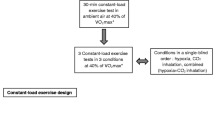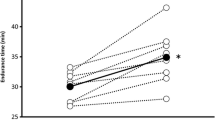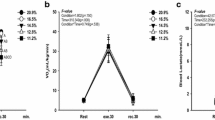Abstract
To test the hypothesis that maximal exercise pulmonary ventilation (\( \dot{V}{\text{E}}_{ \max } \)) is a limiting factor affecting maximal oxygen uptake (\( \dot{V}{\text{O}}_{{ 2 {\text{max}}}} \)) in moderate hypobaric hypoxia (H), we examined the effect of breathing a helium–oxygen gas mixture (He–O2; 20.9% O2), which would reduce air density and would be expected to increase \( \dot{V}{\text{E}}_{ \max } \). Fourteen healthy young male subjects performed incremental treadmill running tests to exhaustion in normobaric normoxia (N; sea level) and in H (atmospheric pressure equivalent to 2,500 m above sea level). These exercise tests were carried out under three conditions [H with He–O2, H with normal air and N] in random order. \( \dot{V}{\text{O}}_{{ 2 {\text{max}}}} \) and arterial oxy-hemoglobin saturation (SaO2) were, respectively, 15.2, 7.5 and 4.0% higher (all p < 0.05) with He–O2 than with normal air (\( \dot{V}{\text{E}}_{ \max } \) , 171.9 ± 16.1 vs. 150.1 ± 16.9 L/min; \( \dot{V}{\text{O}}_{{ 2 {\text{max}}}} \), 52.50 ± 9.13 vs. 48.72 ± 5.35 mL/kg/min; arterial oxyhemoglobin saturation (SaO2), 79 ± 3 vs. 76 ± 3%). There was a linear relationship between the increment in \( \dot{V}{\text{E}}_{ \max } \) and the increment in \( \dot{V}{\text{O}}_{{ 2 {\text{max}}}} \) in H (r = 0.77; p < 0.05). When subjects were divided into two groups based on their \( \dot{V}{\text{O}}_{{ 2 {\text{max}}}} \), both groups showed increased \( \dot{V}{\text{E}}_{ \max } \) and SaO2 in H with He–O2, but \( \dot{V}{\text{O}}_{{ 2 {\text{max}}}} \) was increased only in the high \( \dot{V}{\text{O}}_{{ 2 {\text{max}}}} \) group. These findings suggest that in acute moderate hypobaric hypoxia, air-flow resistance can be a limiting factor affecting \( \dot{V}{\text{E}}_{ \max } \); consequently, \( \dot{V}{\text{O}}_{{ 2 {\text{max}}}} \) is limited in part by \( \dot{V}{\text{E}}_{ \max } \), especially in subjects with high \( \dot{V}{\text{O}}_{{ 2 {\text{max}}}} \).


Similar content being viewed by others

Reference
Aaron EA, Seow KC, Johnson BD, Dempsey JA (1992) Oxygen cost of exercise hyperpnea: implications for performance. J Appl Physiol 72:1818–1825
Benoit H, Busso T, Castells J, Geyssant A, Denis C (2003) Decrease in peak heart rate with acute hypoxia in relation to sea level \( \dot{V}{\text{O}}_{{ 2 {\text{max}}}} \). Eur J Appl Physiol 90:514–519
Buono MJ, Maly R (1996) Augmented hyperventilation via normoxic helium breathing does not prevent exercise-induced hypoxemia. Can J Appl Physiol 21:264–270
Byrne-Quinn E, Weil JV, Sodal IE (1971) Ventilatory control in the athlete. J Appl Physiol 30:91–98
Calbet JA, Lundby C (2009) Air to muscle O2 delivery during exercise at altitude. High Alt Med Biol 10:123–134
Calbet JAL, Boushel R, Radegran G, Sondergaard H, Wagner PD, Saltin B (2003) Determinant of maximal oxygen uptake in severe acute hypoxia. Am J Appl Physiol Regul Integr Comp Physiol 284:R291–R303
Calbet JA, Gonzalez-Alonso J, Helge JW, Søndergaard H, Munch-Andersen T, Boushel R, Saltin B (2007) Cardiac output and leg and arm blood flow during incremental exercise to exhaustion on the cycle ergometer. J Appl Physiol 103(3):969–978
Derchak PA, Stager JM, Tanner DA, Chapman RF (2000) Expiratory flow limitation confounds ventilatory response during exercise in athletes. Med Sci Sports Exerc 32:1873–1879
di Prampero PE (2003) Factors limiting maximal performances in humans. Eur J Appl Physiol 90:420–429
Erickson BK, Seaman J, Kubo K, Hiraga A, Kai M, Yamaya Y, Wagner PD (1994) Effect of helium-induced ventilatory unloading on breathing and diaphragm EMG in awake ponies. J Appl Physiol 77:452–462
Erickson BK, Seaman J, Kubo K, Hiraga A, Kai M, Yamaya Y, Wagner PD (1995) Hypoxic helium breathing does not reduce alveolar-arterial PO2 difference in the horse. Respir Physiol 100:253–260
Esposito F, Ferretti G (1997) The effects of breathing He–O2 mixtures on maximal oxygen consumption in normoxic and hypoxic men. J Physiol 503:215–221
Ferretti G, di Prampero PE (1995) Factors limiting maximal O2 consumption: effects of acute changes in ventilation. Respir Physiol 99:259–271
Ferretti G, Moia C, Thomet J, Kayser B (1997) The decrease of maximal oxygen consumption during hypoxia in man: mirror image of oxygen equilibrium curve. J Physiol 498:231–237
Fulco CS, Rock PB, Cymerman A (1998) Maximal and submaximal exercise performance at altitude. Aviat Space Environ Med 69:793–801
Gavin TP, Derchak PA, Stager JM (1998) Ventilation’s role in the decline in \( \dot{V}{\text{O}}_{{ 2 {\text{max}}}} \) and SaO2 in acute hypoxic exercise. Med Sci Sports Exerc 30:195–199
Harms CA, Babrock MA, McClaran SR, Pegelow DF, Nickele GA, Nelson WB, Dempsey JA (1997) Respiratory muscle work compromises leg blood flow during maximal exercise. J Appl Physiol 82:1573–1583
Harms CA, Wetter TJ, McClaran SR, Pegelow DF, Nickele GA, Nelson WB, Dempsey JA (1998) Effect of respiratory muscle work on cardiac output and its distribution during maximal exercise. J Appl Physiol 85:609–618
Harms CA, Wetter TJ, St Croix CM, Pegelow DF, Dempsey JA (2000) Effect of respiratory muscle work on exercise performance. J Appl Physiol 89:131–138
Holmberg HC, Calbet JA (2007) Insufficient ventilation as a cause of impaired pulmonary gas exchange during submaximal exercise. Respir Physiol Neurobiol 157:348–359
Hopkins SR (2006) Exercise induced arterial hypoxemia: the role of ventilation–perfusion inequality and pulmonary diffusion limitation. Adv Exp Med Biol 588:17–30
Hopkins SR, McKenzie DC (1989) Hypoxic ventilatory response and arterial desaturation during heavy work. J Appl Physiol 67:1119–1124
Johnson BD, Saupe KW, Dempsey JA (1992) Mechanical constraints on exercise hyperpnea in endurance athletes. J Appl Physiol 73:874–886
Koistinen P, Takala T, Martikkala V, Leppaluoto J (1995) Aerobic fitness influences the response of maximal oxygen uptake and lactate threshold in acute hypobaric hypoxia. Int J Sports Med 16:78–81
Lawler J, Powers SK, Thompson D (1988) Linear relationship between VO2max and VO2max decrement during exposure to acute hypoxia. J Appl Physiol 64:1486–1992
Martin D, O’Kroy J (1993) Effects of hypoxia on the VO2max of trained and untrained subjects. J Sports Sci 11:37–42
McClaran SR, Harms CA, Pegelow DF, Dempsey JA (1998) Smaller lungs in women affect exercise hyperpnea. J Appl Physiol 84:1872–1881
Mink SN, Wood DH (1980) How does HeO2 increase maximum expiratory flow in human lungs? J Clin Invest 66:720–729
Mollard P, Woorons X, Letournel M, Lamberto C, Favret F, Pichon A, Beaudry M, Richalet JP (2007) Determinants of maximal oxygen uptake in moderate acute hypoxia in endurance athletes. Eur J Appl Physiol 100:663–673
Ogawa T, Hayashi K, Ichinose M, Nishiyasu T (2007) Relationship between rest ventilatory chemosensitivity and maximal oxygen uptake in moderate hypobaric hypoxia. J Appl Physiol 103:1221–1226
Ohyabu Y, Usami A, Ohyabu I, Ishida Y, Miyagawa C, Arai T, Honda Y (1990) Ventilatory and heart rate chemosensitivity in track-and-field athletes. J Appl Physiol 59:460–464
Papamoschou D (1995) Theoretical validation of the respiratory benefits of helium–oxygen mixtures. Respir Physiol 99:183–190
Powers SK, Jacques M, Richard R, Beadle RE (1986) Effects of breathing a normoxic He–O2 gas mixture on exercise tolerance and VO2max. Int J Sports Med 7:217–221
Richardson RS, Knight DR, Poole DC, Kurdak SS, Hogan MC, Grassi B, Wagner PD (1995) Determinants of maximal exercise VO2 during single leg knee-extensor exercise in humans. Am J Physiol 268:H1453–HH1461
Richardson RS, Grassi B, Gavin TP, Haseler LJ, Tagore K, Roca J, Wagner PD (1999) Evidence of O2 supply-dependent VO2max in the exercise-trained human quadriceps. J Appl Physiol 86:1048–1105
Robach P, Calbet JA, Thomsen JJ, Boushel R, Mollard P, Rasmussen P, Lundby C (2008) The ergogenic effect of recombinant human erythropoietin on VO2max depends on the severity of arterial hypoxemia. PLoS One 3(8):e2996
Torre-Bueno JR, Wagner PD, Saltzman HA, Gale GE, Moon RE (1985) Diffusion limitation in normal humans during exercise at sea level and simulated altitude. J Appl Physiol 58:989–995
Vella CA, Marks D, Robergs RA (2006) Oxygen cost of ventilation during incremental exercise to VO2max. Respiology 11:175–181
Wagner PD (1987) The lungs during exercise. News Physiol Sci 2:6–10
Wehrlin JP, Hallén J (2006) Linear decrease in VO2max and performance with increasing altitude in endurance athletes. Eur J Appl Physiol 96:404–412
Woorons X, Mollard P, Lamberto C, Letournel M, Richalet JP (2005) Effect of acute hypoxia on maximal exercise in trained and sedentary women. Med Sci Sports Exerc 37:147–154
Acknowledgments
We are grateful to the University of Tsukuba track-and-field distance team for participation in this study. This study was supported by grants from University of Tsukuba Research Projects, COE projects and the Ministry of Education, Science and Culture, Japan, and supported also in part by the Spanish Ministry of Science and Technology (DEP2009-11638).
Author information
Authors and Affiliations
Corresponding author
Additional information
Communicated by Guido Ferretti.
Rights and permissions
About this article
Cite this article
Ogawa, T., Calbet, J.A.L., Honda, Y. et al. The effects of breathing a helium–oxygen gas mixture on maximal pulmonary ventilation and maximal oxygen consumption during exercise in acute moderate hypobaric hypoxia. Eur J Appl Physiol 110, 853–861 (2010). https://doi.org/10.1007/s00421-010-1570-z
Accepted:
Published:
Issue Date:
DOI: https://doi.org/10.1007/s00421-010-1570-z



